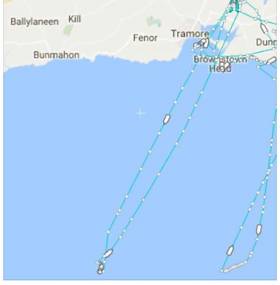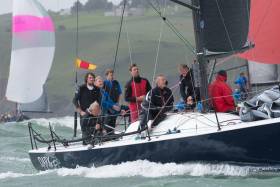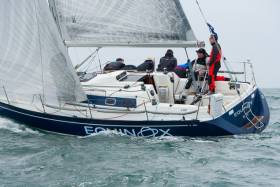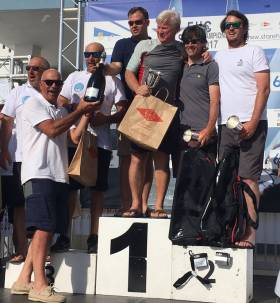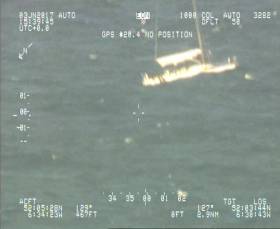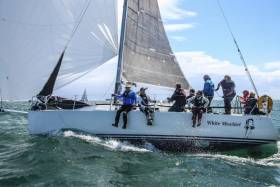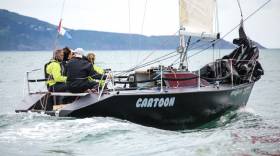Displaying items by tag: Royal Cork Yacht Club
Yachtsman in Hospital After Being Washed Overboard On Return Voyage From Royal Cork ICRA Championships
An ICRA competitor is in hospital today after being washed overboard on the return voyage from the championships at Royal Cork Yacht Club yesterday.
The Dublin Bay competitor ran into problems off the Waterford/Wexford coast last night.
Yesterday's last day of the ICRA event was cancelled due to strong winds.
It is the second serious accident to befall yachts on passage to and from this year's event.
Nine days ago, a Scottish competitor sank off the Saltee Islands on their way to the championships.
Rescue helicopter 117 was sent on a mission to rescue a crew member of the 33–foot yacht that was 'washed overboard by a large wave'.
The accident happened 15–miles offshore. A westely gale was blowing and sea conditons at the time were decribed as 'rough' by the Coastguard.
The remaining two crew onboard the yacht managed to recover their crew–mate from the water in very difficult circumstances.
The wave activated the yachts life raft which then trailed astern of the yacht.
According to the Coastguard, in the rough sea conditions, the R117 helicopter crew decided the safest place to put their winchman was into the life raft. The winchman then climbed onto the yacht and winched the 'ill' crew member from the yacht and brought him back to Waterford Airport where he was taken to hospital by the Ambulance Service.
Dunmore East RNLI lifeboat escorted the yacht to Dunmore East harbour. Local sources say the racing yacht will remain at the harbour for the coming days.
Further updates as we have them.
Bob Bateman's photo–gallery from this afternoon's second day of racing at the 2017 ICRA National Championships at Royal Cork Yacht Club is below.
WM Nixon's second day race report is here.
ICRA Nationals At Royal Cork: Photo Gallery – Day One
A highly anticipated ICRA National Championships got underway at Royal Cork Yacht Club this afternoon with two races successfully completed before the weather is expected to take a turn for the worse tomorrow.
WM Nixon has wrapped up the first day in his report and results here and Bob Bateman's ICRA day one photo gallery is below:
Did Failed Seacock Sink Inis Mor?
While everyone is very relieved and grateful that the crew of the Scottish-owned Ker 39 Inis Mor were saved after their boat sank at the Saltees at the weekend while on passage to Cork for the up-coming ICRA Nationals, there is still a sense of shock that a boat which was a successful veteran of three Round Ireland Races should have gone down so suddenly writes W M Nixon.
Inis Mor is best known in Irish sailing for her years campaigned by the Gouy family of France, who won an RORC Championship with her thanks to their overall win in the 2012 Round Ireland Race. She was always in the frame, as her other two circuits of Ireland notched her a second and a third. And her gallant owners further endeared themselves to the Irish sailing community through being entered for the Round Ireland Race as representing the Clifden Boat Club, as they have a property in Connemara.
Inis Mor was sold to top Scottish skipper Jonathan Anderson, whose own formidable track record at the sharp end of the fleet made the Anderson/Inis Mor equipe’s debut in Cork a keenly-anticipated event. Thus the news of this sinking, apparently caused by a failed toilet seacock with an ingress of water which was not obvious until it was too late to do anything to effectively seal it off, brings a sense of shock, and an added awareness that in a stripped-down racing boat, almost any equipment failure can have cumulative and potentially disastrous effects if not immediately dealt with.
ICRA Commodore Thankful to Coast Guard & RNLI for Rescue of Crew From Sunken Scottish Yacht Inis Mor
ICRA Commodore Simon McGibney has expressed relief that everyone is safe after the weekend loss of Scottish competitor Inis Mor on its way to the ICRA National Championships at Royal Cork Yacht Club.
As Afloat.ie reported on Saturday, the Cruisers Zero Ker 39 sank off the Saltee Islands. All three crew were rescued by Coast Guard Helicopter.
“We are saddened by the loss of Inis Mór and the absence of our Scottish friends from the championship but we are enormously relieved that nobody was injured or worse during the sinking,” said McGibney. “We are thankful, as always for the professionalism of the Irish Coast Guard crew on Rescue 117 for winching the sailors to safety and to the Kilmore Quay RNLI lifeboat crew for their efforts to save the yacht.”
Bright and breezy conditions are on the cards for next weekend’s Irish Cruiser Racing Association’s annual championships at Crosshaven where a fleet of 60 boats from around Ireland are expected to contest four national titles.
A steady stream of boats arriving by road at the Royal Cork Yacht Club marked the build-up to the event over the weekend with several crews expected on the water on Thursday for training practice.
All four national champions will be defending their titles led by ICRA Boat of the Year, John Maybury’s Joker 2 from the Royal Irish YC who is aiming for a hat-trick victory in Class 1 this year. Class Zero champion Conor Phelan on Jump Juice will be without the Scottish challenger Inis Mor. Howth YC’s David Cullen arrived by road with Checkmate XV on Monday while Ken Lawless and Sybil McCormacks’ Cartoon from the Royal Irish YC is also ready to defend their Class 3 title. Read more in Afloat's runners and riders preview here.
Foynes based McGibney says 'safety will be upper-most in the ICRA event organisers’ thoughts' this weekend as current forecasts suggest winds in the upper-range of racing conditions for at least part of the event.
Now the largest stand alone dinghy festival event in the country, the official launch of Cork Dinghy Fest took place in the Royal Cork Yacht Club last week with representatives from event sponsors, CH Marine, Zhik and the Port of Cork all present. Chairman for the event Nicolas O’Leary was accompanied by Royal Cork Yacht Club Vice Admiral Pat Farnan and Rear Admiral for Dinghies Stephen O’Shaughnessy.
Nicolas O’Leary, event chairman is looking forward to another great event and was very excited with the new introduction of the extreme fleet for the 2017 event, the arena style racing for foiling Moths and 29’er etc. will be a great spectacle for everyone.
2017 is gearing up to be a great event, says O'Leary, who says it was great to have such support from our sponsors this year.
As previously reported by Afloat.ie, returning to Cork Dinghy Fest are the ever strong and growing RS fleet of RS 400’s, 200’s and Fevas. The feature event this year is the RS 200 National Championships and Euro Cup, and having seen a surge in popularity in Cork this winter, over 30 boats are expected in the RS 200 fleet alone.
Also return is the 420 class, they will be deciding their national champion again during Cork Dinghy Fest. While the National 18-foot class will be holding their National Championships.
Royal Cork Yacht Club brothers Peter and Rob O'Leary were second overall in the Star class Eastern Hemisphere Championships in Viareggio, Italy yesterday. The O'Leary's were runners–up to, Andrew MacDonald and Brad Nichol USA Diego Negri and Sergio Lambertenghi of Italy were third. Participation at the event brought double Olympian Peter O'Leary back to his days at London 2012, the last time the 22–foot keelboat sailed as an Olympic class.
70 teams from 15 countries were represented at the Tuscany event.
The next big event for the Star class is the Western Hemisphere in Cleveland, Ohio in June and the Star World Championship in Denmark in July.
Scottish Yacht 'Inis Mor' Sinks On Way to ICRA Championships at Royal Cork, All Crew Safe
The yacht that sank off Wexford yesterday afternoon was the Scottish–owned Ker 39 Inis Mor. The top performer was en route to the Irish Cruiser Racer Association (ICRA) National Championships that begin at Royal Cork Yacht Club in Cork Harbour on Thursday.
A social media post by the crew last night said: 'By now a lot of you may have heard the sad news. We are all glad that Clarke, Bob and Clara are safe and well. Unfortunately this afternoon Inis Mor sunk whilst on her way to Crosshaven. Clearly we are all absolutely gutted but very thankful to the [Coastguard] Rescue 117 helicopter crew who got the guys out the life raft and the Kilmore Quay RNLI team who came to assist'.
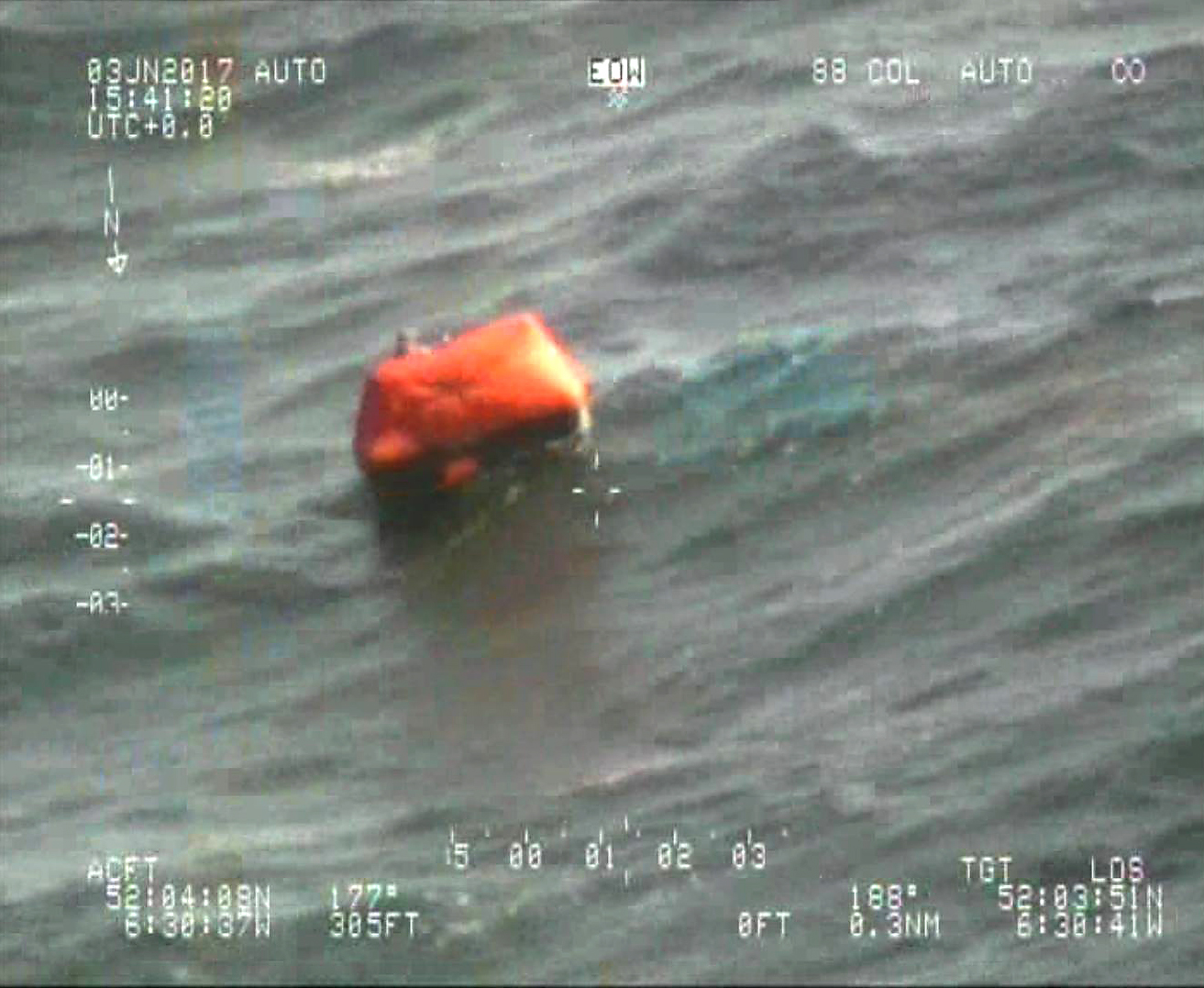 The crew, two men and a woman, evacuated to a liferaft (one crew visible top left of raft). Photo: Rescue 117
The crew, two men and a woman, evacuated to a liferaft (one crew visible top left of raft). Photo: Rescue 117
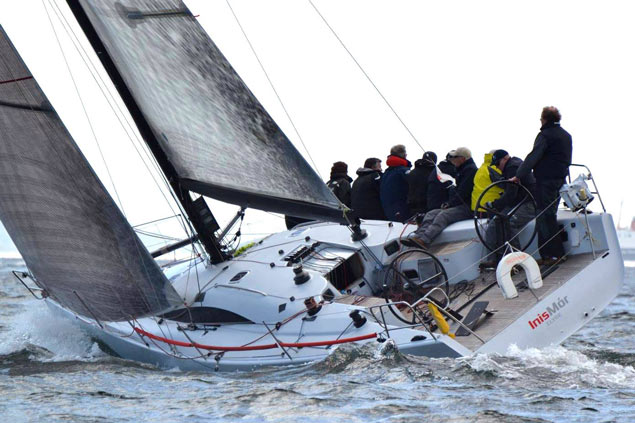 Clyde–based Inis Mor, a Ker 39, was due to race at the ICRA championships on Thursday. Photo: Facebook/Inis Mor
Clyde–based Inis Mor, a Ker 39, was due to race at the ICRA championships on Thursday. Photo: Facebook/Inis Mor
 The yacht made good progress from the Clyde to Scotland and called in to Dun Laoghaire on its passage down the Irish Sea. Screengrab: Marine Traffic
The yacht made good progress from the Clyde to Scotland and called in to Dun Laoghaire on its passage down the Irish Sea. Screengrab: Marine Traffic
As Afloat.ie reported earlier, the three sailors were rescued by Coastguard Helicopter and brought to Waterford airport.
Rescue 117 reported it was tasked to a yacht sinking off the Saltee Islands on social media: 'The yacht crew had issued a Mayday call and had taken to their life-raft. The life-raft was spotted 11 miles away by our winchman on the FLIR (Forward Looking Infrared) camera. Rescue 117 winched the three crew from the life-raft to the safety of the aircraft. They did not require any medical attention. Kilmore Quay lifeboat were also on scene. The yacht sank shortly after'.
The yacht, one of several international competitors travelling to the event, was one of four competing in Class Zero of the Cork Harbour based Championships. Read Afloat.ie's ICRA Runners and Riders event preview here.
Inis Mor is a 39–footer and a previous winner of the Round Ireland Race.
Kilmore Quay RNLI attempted to keep the yacht afloat with pumps after it began to sink in ten–foot swells off the Saltee Islands.
 Yesterday's Facebook post on social media from onboard confirmed Inis Mor's location on the south coast and her final destination but just hours later the yacht sank (below) Screengrab: Marine Traffic
Yesterday's Facebook post on social media from onboard confirmed Inis Mor's location on the south coast and her final destination but just hours later the yacht sank (below) Screengrab: Marine Traffic
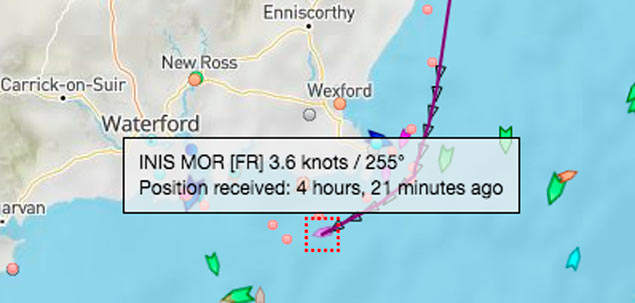
The Clyde–based yacht was was one of the biggest boats entered in the ICRA championships and was to compete at the three-day annual regatta starting on Thursday.
Afloat.ie sources say problems started when a toilet cracked on board and this led to the water ingress.
ICRA National Championships 2017: Runners & Riders
Class bands released for next week's ICRA National Championship (see below) reveal a smaller than usual fleet for the Royal Cork Yacht Club Championships but with three events in three weeks all trying to attract boats out of Dublin where 90% of boats are based, it was always going to be a tough nut to crack. Championship fleet sizes will range from four boats in Class Zero to fourteen in Class Four where there will be some great battles for national honours starting next Thursday in Crosshaven. With early forecasts showing strong south-westerly winds prevailing, Afloat.ie sticks its neck out in a 'Runners and Riders' Guide to the 2017 Cork Harbour Championships.
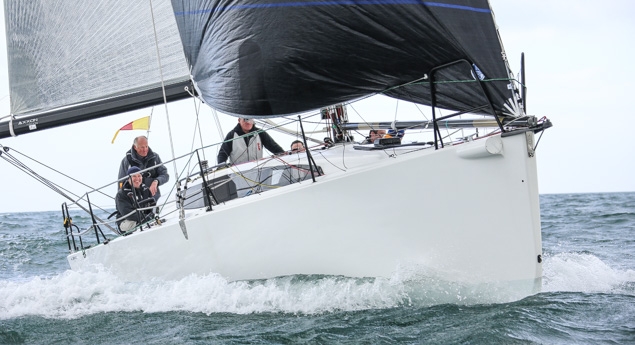 The ISORA front runner Rockabill VI, the JPK 10.80 is from the Royal Irish Yacht Club Photo: Afloat.ie
The ISORA front runner Rockabill VI, the JPK 10.80 is from the Royal Irish Yacht Club Photo: Afloat.ie
Class 0 There are just four boats in Class Zero and two are travellers to Cork Harbour. The Dubois 37, Dark Angel, ex–Antix, with Rob O'Leary onboard, won at Cork Week last year beating local favourite Jump Juice (Ker 37) for the top spot, so this pair are likely to produce another close battle next week. If winds are strong, a previous Round Ireland winner, Inis Mor, a Ker 39, will be a force to be reckoned with. [See update: Inis Mor sinks on way to championships –Ed.] The fourth boat entered is a Salona 45, Meridian. With half of the Zero fleet travelling to Cork for the event, the hope is the strong south–westerlies won't deter.
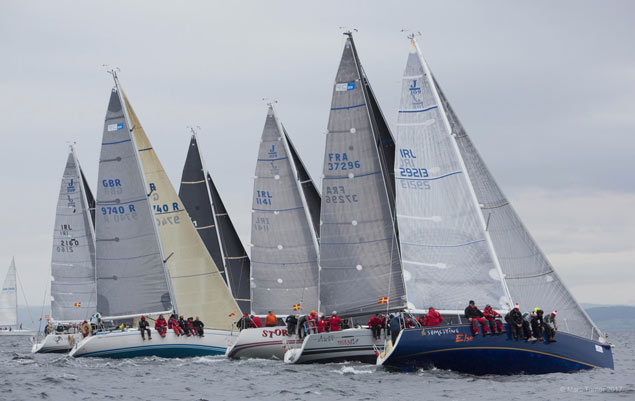 Pat Kelly's J109 Storm has already won in Scotland (above) this season and is race–ready for the ICRA Nationals. Photo: Marc Turner Class 1 Only the four top J109’s from the 2016 ICRAs are turning up in Cork for this nine–boat class. Joker II, Storm, White Mischief and Jigamaree. The new Dublin Bay J109’s of Andrew Craig and Andrew Algeo are not entered. Algeo's Juggerknot is opting for the D2D and Sovereigns but not ICRAs. The JPK10.80 Rockabill VI (Paul O'Higgins) from the Royal Irish Yacht Club has already shown his potency offshore this season in the ISORA series, pundits say she will be strong in Cork too if all three days are sailed in strong winds, but one light day may prove her undoing. ICRA Boat of the Year, John Maybury's Joker II is going for three–in–a–row of ICRA wins, with Star keelboat Olympian Mark Mansfield as Tactician. Pat Kelly's Storm, fresh from a class win at last month's Scottish Series will certainly be in the mix. The Rush Sailing Club boat has now changed to symmetrical spinnakers which will give her an edge if winds are stronger. Kelly was afloat early this year and competing in the Spring Warmer in Howth and then HYC Wednesday nights. It means this team is race–ready as they have already proved in Scotland. Whether or not the new kite is paying dividends has not been disclosed. A tight–lipped Ronan Kelly told Afloat.ie: 'We can't really give that much feedback as it is very much in the early stages of trial for us'. The IRC rating is slightly higher than Storm had prior to the change in spinnakers. And the decision to change, says Ronan Kelly, was based on the notion of 'why not try something different out?'
Pat Kelly's J109 Storm has already won in Scotland (above) this season and is race–ready for the ICRA Nationals. Photo: Marc Turner Class 1 Only the four top J109’s from the 2016 ICRAs are turning up in Cork for this nine–boat class. Joker II, Storm, White Mischief and Jigamaree. The new Dublin Bay J109’s of Andrew Craig and Andrew Algeo are not entered. Algeo's Juggerknot is opting for the D2D and Sovereigns but not ICRAs. The JPK10.80 Rockabill VI (Paul O'Higgins) from the Royal Irish Yacht Club has already shown his potency offshore this season in the ISORA series, pundits say she will be strong in Cork too if all three days are sailed in strong winds, but one light day may prove her undoing. ICRA Boat of the Year, John Maybury's Joker II is going for three–in–a–row of ICRA wins, with Star keelboat Olympian Mark Mansfield as Tactician. Pat Kelly's Storm, fresh from a class win at last month's Scottish Series will certainly be in the mix. The Rush Sailing Club boat has now changed to symmetrical spinnakers which will give her an edge if winds are stronger. Kelly was afloat early this year and competing in the Spring Warmer in Howth and then HYC Wednesday nights. It means this team is race–ready as they have already proved in Scotland. Whether or not the new kite is paying dividends has not been disclosed. A tight–lipped Ronan Kelly told Afloat.ie: 'We can't really give that much feedback as it is very much in the early stages of trial for us'. The IRC rating is slightly higher than Storm had prior to the change in spinnakers. And the decision to change, says Ronan Kelly, was based on the notion of 'why not try something different out?'
Tim Goodbody's J109 White Mischief is also very likely to be in the mix. Rob McConnell's A35 Fools Gold (second in Scotland last month) will be competitive, especially in stronger winds and former winner in ICRA Tralee 2013, the Xp–33 Bon Exemple (Colin Byrne of the Royal Irish) is also expected to be there or thereabouts. This will be a very competitive class, and wind conditions will likely make a big difference with Joker II the favourite in the mixed conditions but if it is strong on all three days, Rockabill VI is a likely winner.
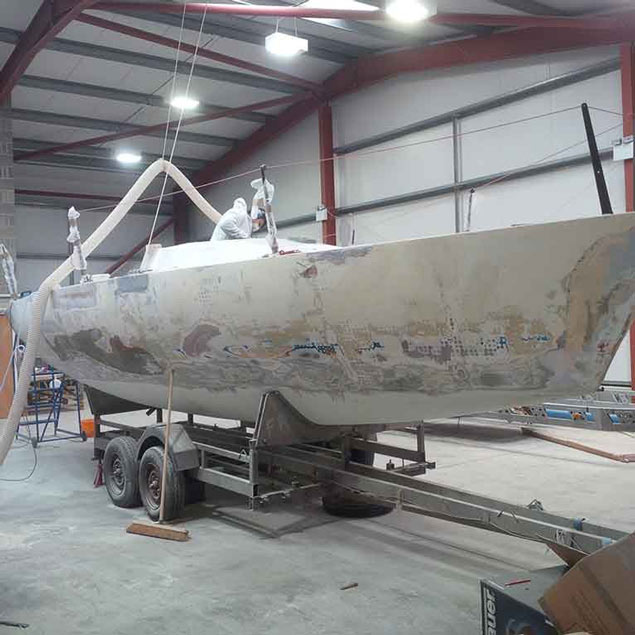 Checkmate XVIII – the old Emiliano Zapata, ex Dick Dastardly, ex French Beret, ex Concorde from 1985 is undergoing a refit in North Wales and hopes to be at the ICRA Nationals in Cork Class 2 Normally, the Half tonners would be favourites in this 12-boat class and any one of Checkmate, Harmony or Big Picture could take it, especially if the conditions are mixed or lighter. Nigel Biggs new Checkmate XVII is entered and this is an unknown factor as is his appearance at all. 'We are putting long hours in at the moment but it's very touch and go. Fingers crossed...' he told Afloat.ie. If conditions are strong expect to see Ross McDonald's X-332 Equinox from Howth to be a dominant player, as she was at the 2015 ICRAs in Kinsale when she won easily in stronger winds. Paul Tingle's X34 Alpaca, as top–rated boat in this class, also could be a wild card.
Checkmate XVIII – the old Emiliano Zapata, ex Dick Dastardly, ex French Beret, ex Concorde from 1985 is undergoing a refit in North Wales and hopes to be at the ICRA Nationals in Cork Class 2 Normally, the Half tonners would be favourites in this 12-boat class and any one of Checkmate, Harmony or Big Picture could take it, especially if the conditions are mixed or lighter. Nigel Biggs new Checkmate XVII is entered and this is an unknown factor as is his appearance at all. 'We are putting long hours in at the moment but it's very touch and go. Fingers crossed...' he told Afloat.ie. If conditions are strong expect to see Ross McDonald's X-332 Equinox from Howth to be a dominant player, as she was at the 2015 ICRAs in Kinsale when she won easily in stronger winds. Paul Tingle's X34 Alpaca, as top–rated boat in this class, also could be a wild card.
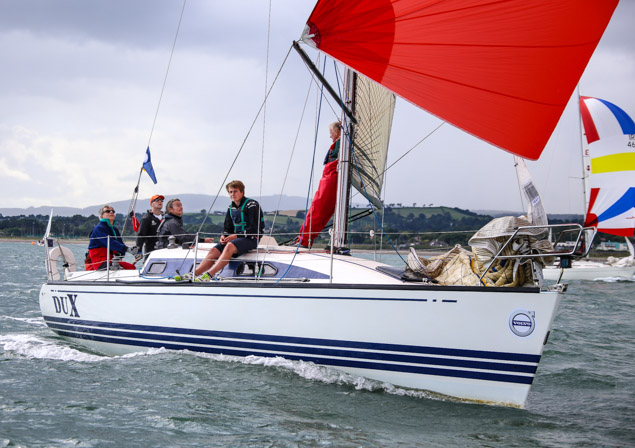 Stronger conditions may suit X302s like Dux from Howth Yacht Club Photo: Afloat.ie
Stronger conditions may suit X302s like Dux from Howth Yacht Club Photo: Afloat.ie
Class 3 The quarter tonners, like the half tonners in class 2 are bottom of this the second biggest class of the ICRA championships with 13 entered. If conditions are light or mixed, expect Paul Gibbons Anchor Challenge to be strong. She has Olympian Kiliian Collins onboard and they will give Ken Lawless’s Cartoon, 2016 ICRA winner, a tough challenge. If conditions are stronger then the Corby 25’s Fusion and Stonehaven racing will be up there as will the two X302’s, Dux and Maximus. The Sigma 33’s could also prove competitive in the breeze. In a mixed event, however, the money would be on Anchor Challenge to take it.
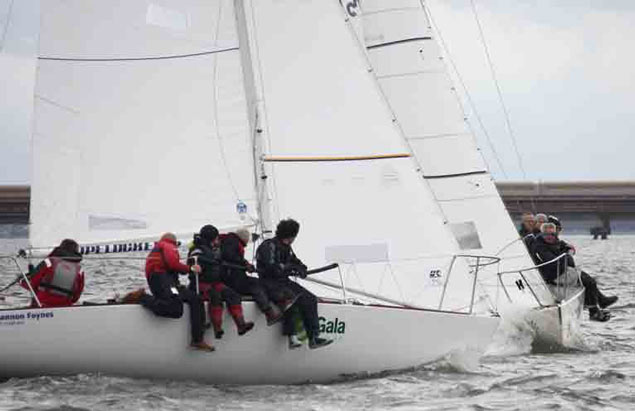 Close racing for the 16–boat J24 fleet at Foynes Yacht Club, ten J24s including Gala Racing (above) will be in Cork
Close racing for the 16–boat J24 fleet at Foynes Yacht Club, ten J24s including Gala Racing (above) will be in Cork
Class 4 There are 10 J24’s in this class of 14, the event's biggest fleet, and the winner will very likely come from one of them. Corkman, Flor O'Driscoll, with his local knowledge, should be up there on Hard on Port. However, this is a close class and hard to call.
ICRA Nationals 2017 – Class Divisions (as at June 2, 2017). Data supplied by ICRA
| DIVISION | BOAT NAME | TYPE |
|---|---|---|
| 0 | Inis Mor | Kerr 39 |
| 0 | Meridian | Salona 45 |
| 0 | Jump Juice | Ker 37 |
| 0 | Dark Angel | Dubois 37 |
| 1 | Rockabill VI | JPK 10.80 |
| 1 | Saxon Senator | X37 |
| 1 | Fools Gold | A35 |
| 1 | Altair | First 36.7 |
| 1 | Storm | J109 |
| 1 | Joker 2 | J109 |
| 1 | Jigamaree | J109 |
| 1 | White Mischief | J109 |
| 1 | Bon Exemple | XP33 |
| 2 | Alpaca | X-34 |
| 2 | Ellida | X-332 |
| 2 | Equinox | X-332 |
| 2 | Coracle IV | Olson 30 |
| 2 | Jostler | J92 |
| 2 | Jedi | J80 |
| 2 | Rioja | J80 |
| 2 | Artful Dodger | Elan 333 |
| 2 | Slack Alice | GK34 |
| 2 | Harmony | 1/2 Tonner |
| 2 | Checkmate XV | Mod 1/2 Ton |
| 2 | Checkmate XVII | Mod 1/2 Ton |
| 3 | Fusion | Corby 25 |
| 3 | Bad Company | Sunfast 32 |
| 3 | Stonehaven Racing | Corby 25 |
| 3 | Maximus | X-302 |
| 3 | Dux | X-302 |
| 3 | Luas | HB31 |
| 3 | Sea Hawk | Sigma 33 |
| 3 | Flyover | Sigma 33 00D |
| 3 | Cri-Cri | 1/4 ton |
| 3 | Powder Monkey | Sigma 33 |
| 3 | No Gnomes | Nicholson 30 |
| 3 | Cartoon | 1/4 ton |
| 3 | Manzanita | 1/4 ton |
| 4 | Jade | J24 |
| 4 | K25 Team Scandal | J24 |
| 4 | Jumpin' Jive | J24 |
| 4 | Hard on Port | J24 |
| 4 | Stouche | J24 |
| 4 | Johnny Bravo | J24 |
| 4 | Jana | J24 |
| 4 | Gala Racing | J24 |
| 4 | Ya Gotta Wanna | J24 |
| 4 | Jelignite | J24 |
| 4 | Bandit | Mod Bolero 26' |
| 4 | Relativity | Albin Express |
| 4 | Whistlin Dixie | Impala 28 |
| 4 | Raffles | Sadler32 |
| Non Spin | Rebellion | Lambay 60 |
| Non Spin | Nieulargo | Grand Soleil 40 |
| Non Spin | Indulgence | Dehler 365 |
| Non Spin | Aisling | Dufour 365 |
| Non Spin | Sweet Dreams | Sun Odyssey 36 |
| Non Spin | Surfdancer | Elan 333 |
| Non Spin | Roaring Forthyes | Beneteau 35s5 |
| Non Spin | Privateer | Dufour 365 |
| Non Spin | Lady T | Sun Odyssey 32i |
| Non Spin | Loch Greine | Hanse 31 |
| Non Spin | Aramis | Contessa 33 |
| Non Spin | Cracker | Trapper T250 |
| Non Spin | Speedy Gonzales | Jaguar 27 |
ICRA National Champions Will Defend Titles at Royal Cork Yacht Club, 60–Boat Fleet Assemble for Crosshaven Event
All four major title-holders from last year’s Irish Cruiser Racing Association (ICRA) national championships will be in action in a fortnight when a fleet of over 60 boats from around Ireland will gather at the Royal Cork Yacht Club, Crosshaven to decide the 2017 winners.
The number is up slightly from 56 when ICRA published its provisional entry list on May 8. ICRA has said it will publish class divisions for the fleet closer to the event. In April, ICRA confirmed there would be no crew limit for the championships, and that the IRC Rule 22.4 would stay deleted after discussion earlier in the year on the topic at the ICRA conference.
The closing date for entries is today, Friday 26th May and the €200 entry fee includes free berthing at the RCYC for the event including before and afterwards for visiting boats.
 Half–tonner Checkmate (Dave Cullen) mastered last year's light airs at the Howth championships to win class two. Photo: Afloat.ie
Half–tonner Checkmate (Dave Cullen) mastered last year's light airs at the Howth championships to win class two. Photo: Afloat.ie
As ICRA Boat of the Year, John Maybury’s Joker 2 from the Royal Irish YC will be the headline entry as the Dun Laoghaire yacht aims for a hat-trick victory in Class 1 following wins in 2015 and 2016. However, rival J109’s Storm from Rush Sailing Club and Jigamaree from the RIYC are amongst the pack likely to challenge Maybury’s form.
Class Zero champion Conor Phelan on Jump Juice will have home waters advantage this year against Scottish challenger Inis Mór while Howth YC’s David Cullen on Checkmate XV will be looking to repeat his home waters win last year further south on Cork harbour in Class Two. Ken Lawless and Sybil McCormacks’ Cartoon from the Royal Irish YC will defend their Class 3 title.
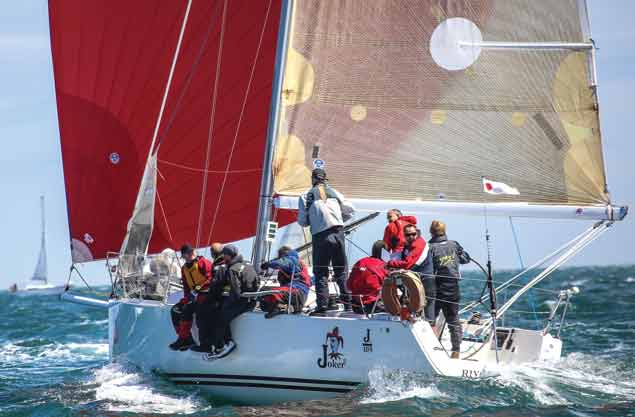 Dublin Bay based ICRA class one champion Joker 2 from will defend at Royal Cork. Photo: Afloat.ie
Dublin Bay based ICRA class one champion Joker 2 from will defend at Royal Cork. Photo: Afloat.ie
"A strong turnout from the host region is welcome and although overall numbers are down on 2016, the top boats have all committed to the championship,” said Simon McGibney, ICRA Commodore from Foynes. “There was also an unfortunate fixtures clash that we intend to avoid in future but for this season, under the circumstances we’re happy with quality over quantity.”
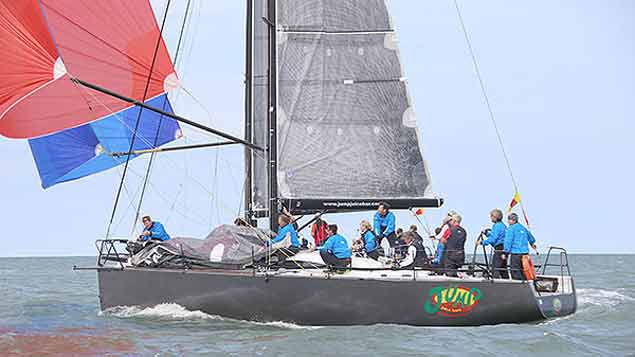 Conor Phelan’s Jump Juice will defend class zero title on home waters at Crosshaven. Photo: Afloat.ie
Conor Phelan’s Jump Juice will defend class zero title on home waters at Crosshaven. Photo: Afloat.ie
A new Coastal division will be introduced subject to demand and following the successful implementation in 2016, the Progressive ECHO system will now be standard for the ICRA nationals across all classes.
Class bands will be decided next week and will be announced together with proposals to address the fixtures congestion for future seasons.
The ICRA National Championships hosted by the Royal Cork Yacht Club will be sailed from Friday 9th to Sunday 11th June 2017.


























